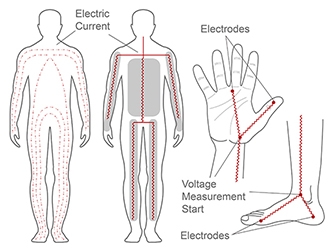-
1. Multiple Frequencies
Traditional BIA devices estimate body composition using one frequency (50kHz is most commonly used). The frequency of the current affects the resistance of biological conductors. Because low frequencies have difficulty overcoming and passing through cell membranes, they are well-suited for measurement of extracellular water
High frequency currents can pass through cell membrane walls, making it possible to measure intracellular water.
That's why Charder's Body Composition Analyzers use multiple frequencies, using direct measurements to provide more detailed analysis of body composition, particularly relating to body water balance, which is a crucial output parameter when it comes to disease management and rehabilitation.

-
2. Segmental Measurements
When first invented, BIA treated the body as a single cylinder, using whole-body impedance to calculate output parameters. Generally, this is done by measuring the impedance of two "cylinders" (foot-to-foot or hand-to-hand), using those values to estimate values for the rest of the body. Another method is to attach electrodes to the right foot and right leg, measuring impedance for that half of the body. This may work relatively well for subjects with "standard" body types, but the level of accuracy decreases significantly for other groups.
Shape, relative muscularity, and length of the trunk, arms, and legs can vary significantly between people and populations. If a subject with a highly muscular upper body and relatively thin legs uses a foot-to-foot BIA device, it is quite probable that overall muscle estimates will be inaccurate, as the upper body's impedance is not measured.
To avoid this potential measurement error, and to better measure the torso in particular (which comprises roughly half of total body mass in most people, yet cannot be measured with traditional BIA devices), Charder's BIA devices use segmental measurements that independently measure impedance for the trunk, right arm, left arm, right leg, and left leg, for more accurate results.

-
3. Abdominal Fat Analysis
Obesity has become an increasingly severe health problem in countries all over the world, and many people purchase home use BIA devices to estimate body fat percentage.
However, "body fat" carries different levels of obesity-related health risks depending on where it's located. Body fat can be divided into subcutaneous (beneath the skin) and intra-abdominal fat. Abdominal fat can be further divided into visceral fat and retroperitoneal fat. Visceral fat specifically is highly correlated with risk of obesity-related disease, and it can occur even if a subject's weight or BMI is within standards.
Visceral fat is most accurately measured using computed tomography (CT), but CT scans are expensive and impractical for regular use due to the dose of radiation involved. Charder's Body Composition Analyzers provide estimates of visceral fat, providing a useful and important indicator for regular tracking and control.

-
4. Bioelectrical Impedance Vector Analysis (BIVA)
Obesity has become an increasingly severe health problem in countries all over the world, and many people purchase home use BIA devices to estimate body fat percentage.
In medical settings, quick, accurate, and cost-effective evaluation of a patient's hydration status is a critical part of diagnostics and treatment. Conventional BIA uses regression equations to produce estimates of Total Body Water, Extra- and Intracellular Water. However, because equations are formulated based on "normal" healthy populations and rely upon assumptions about standard hydration level, accuracy of these estimates may vary based on disparity between the subject and comparison population. This is where Bioelectrical Impedance Vector Analysis (BIVA) comes in.
BIVA assesses fluid status and body cell mass through Resistance (R) and Reactance (Xc). Assuming that resistance correlates with body fluid, and reactance correlates with body cell mass, R and Xc are normalized for height, and compared with the reference population. Because R and Xc – unlike body composition estimates – are directly determined by body fluid volume, BIVA can be used as an accurate assessment tool by subjects with abnormal hydration levels, who might not be able to rely upon conventional BIA results.

-
5. Phase Angle
Most BIA parameters describe quantity in a subject. The amount and proportion of body water. The amount of fat. The amount of muscle mass. However, subjects with the same quantity may still have disparity in quality. A ballet dancer, a person who is naturally lean, and a person with anorexia may all have similar height, BMI, and body fat percentage. But are they equally healthy?
To answer this question, BIA devices need to utilize more advanced technology that typically can't be found in your bathroom body fat scale.
The first is phase angle.
What is phase angle, and what can we learn from it?
Due to the capacitive properties of cell membranes, when an electric current passes through a cell, a phase shift between current and voltage occurs, causing a time difference that can be measured in degrees by some modern BIA devices, and is referred to as the phase angle.
Phase angle is thus determined by Reactance (Xc), which correlates with cell integrity, and Resistance (R), which correlates with the distribution of fluid within and outside the cell membrane. A high Xc/R ratio will result in a higher phase angle, and a low Xc/R ratio will result in a lower phase angle.
Generally speaking, a higher phase angle correlates with stronger and thus healthier cell membranes, whereas a lower phase angle may be caused by a breakdown in cell membrane integrity.

Advanced Features
Body Fat Scales are fairly common, and also utilize Bioelectrical Impedance. But what separates professional Body Composition Analyzers from consumer devices?